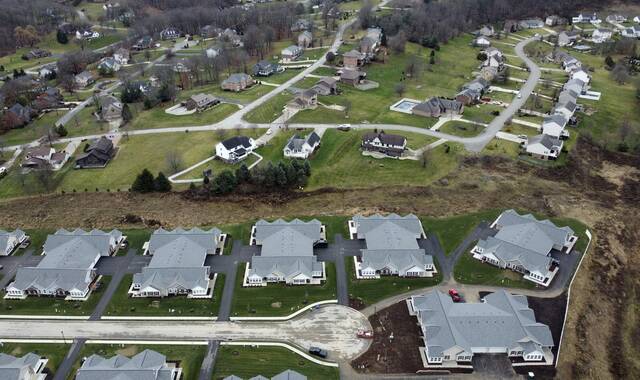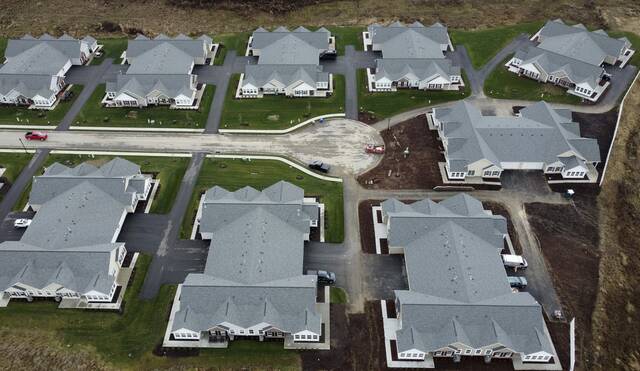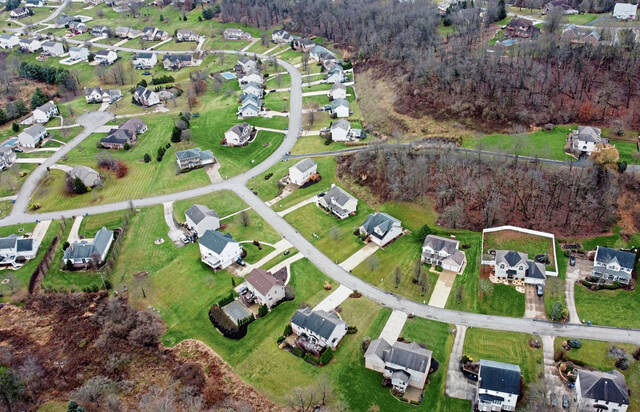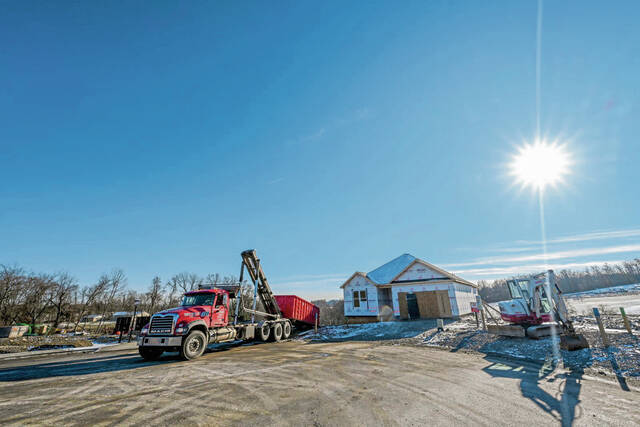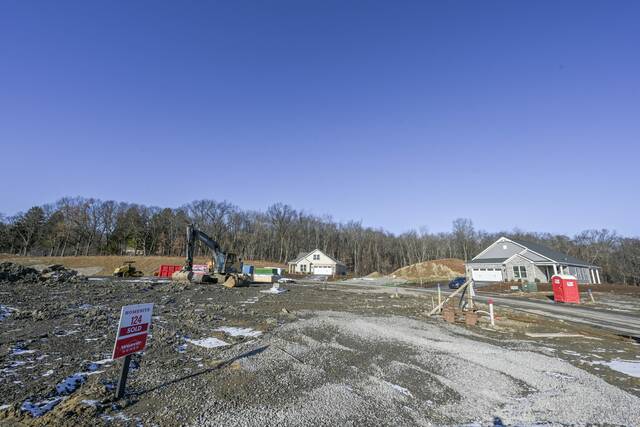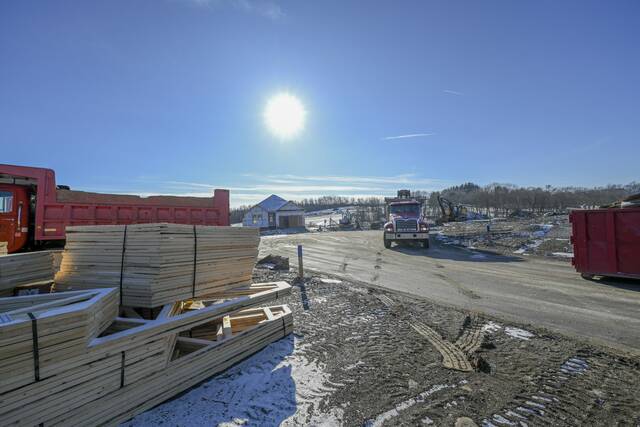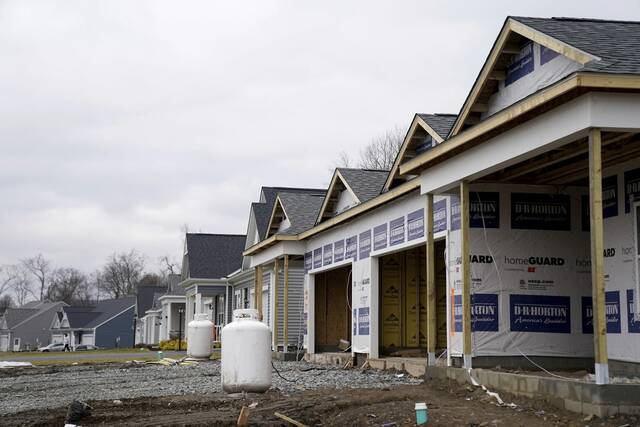Growing pains: Boom towns battle strain on services, streets and schools
What’s happened in other fast-growing towns across Western Pennsylvania is now playing out in Buffalo Township: Farms are becoming homes, homes are attracting businesses and residents are worried their town is becoming “the next Cranberry.”
“I always ask people who say that, ‘What do you mean by that?’” said Dan Santoro, Cranberry Township’s manager. “Increasing property values?”
Santoro, of course, will vouch for his township, but housing booms in Buffalo and other places in Western Pennsylvania give officials more to ponder than just extra tax revenue.
Lots of new residents can strain core services, such as police and sewage treatment, while stress-testing planning and zoning rules likely created decades ago. Just ask North Strabane, which changed its grading requirements in 2018 after losing four homes to a landslide in a newly built subdivision.
Aging schools tend to overflow and force districts to expand buildings or break ground on expensive new ones, a pattern playing out in Mars Area, Canon-McMillan and, to a lesser extent, Hempfield Area school districts.
And for some community members, the arrival of Ryan Homes, Maronda Homes and other builders means the death of their beautiful country backdrop.
“When does the township, when does the community say, enough is enough?” asked Buffalo Township resident Mark Caruso at a recent supervisors meeting. “Can we put the brakes on it?”
So, is going rural to exurban worth it?
“I think that’s a good problem to have,” said North Strabane Manager Andrew Walz. “It’s just figuring out … how do we make that work in a responsible manner?”
Matching services with growth
Residents, for the most part, aren’t exaggerating when they say Buffalo Township is changing.
At least 1,000 homes are slated for construction over the next decade, including more than 600 in a mixed-use development at the intersection of routes 28 and 356.
The average U.S. household consists of 2½ people, so the township can expect to grow from about 8,200 to 10,700 residents — a 30% increase.
Those residents, of course, will need water and sewage service.
As long as planned expansions start soon, the Buffalo Township Municipal Authority should be able to meet the increased demand, according to its chairperson, Eric Smith.
Work on the water plant will come first at a cost of nearly $5 million. Officials are waiting to hear back from the state on grant requests before going ahead with construction. Sewage upgrades will follow.
Sometimes, developers take on the cost of water and sewage upgrades themselves. Weaver Homes is, for instance, building a full-blown wastewater treatment plant for its subdivision in New Sewickley.
Then, there’s the matter of police coverage.
When police Chief Tim Derringer started in the late 1990s, Buffalo Township only had three full-time officers and a handful of part-timers. There were no traffic signals to enforce — just stop signs — and subdivisions were few and far between.
These days, the department boasts 10 officers, but there are still “just not enough to go around,” Derringer said. He welcomes development, he added, but more officers will be needed to handle the larger call volume and patrol footprint.
Hempfield, with a population of about 42,000 and hundreds of homes in the pipeline, has avoided the issue by sticking with free state police coverage. They’re the most populous municipality in the state to do so — a smart decision in the eyes of some outside officials but free-loading in the eyes of others.
Either way, it has helped Hempfield avoid tax increases for more than 30 years through population ups and downs, even as new investments, such as a $2 million fire station upgrade, have been made.
Aaron Siko, Hempfield’s manager, said conversations to start a township police force have come up over the years, but the idea is not being explored at this time.
Roads are another hang-up for growing towns. Case in point: Route 356.
PennDOT has at least twice delayed a project to widen the corridor through the township’s business district. About 18,000 vehicles use that stretch daily — enough to snarl traffic during rush hours and local events, like races at Lernerville Speedway.
The most recent delay for the project happened because of inflation and cost increases on other projects, according to PennDOT spokesperson Christina Gibbs. Funding is the ultimate determinant of project timing, she said, even as community growth heavily influences the design stage.
“If developments or business expansions are in the works, we are aware through our permitting process and our traffic unit and can factor that into our plans,” Gibbs said.
As for other challenges faced by ballooning communities, Department of Community and Economic Development spokesperson Justin Backover cited resident resistance to change as well as the possible harms to community character, vulnerable residents and the environment.
These factors were enough for Buffalo Township supervisors to deny a zoning change Wednesday that would have paved the way for yet another subdivision along the Route 356 corridor.
Recommended bulwarks against negative outcomes, per Backover, include comprehensive planning, proactive zoning amendments and development-specific ordinances. Buffalo has or hopes to check some of these boxes, having implemented a traffic impact fee for new subdivisions and agreeing to craft a 10-year plan alongside Winfield, Clinton, Saxonburg and possibly Jefferson.
More bedrooms, more desks
Canon-McMillan School District gains about 50 students each year as residential development rotates among its communities of Canonsburg, Cecil and North Strabane.
“That has definitely put stress on our building capacities,” said Deputy Superintendent Scott Chambers.
Since 2013, the district has built two schools, renovated its high school twice and is weeks away from breaking ground on the new Wylandville Elementary School in North Strabane.
In the meantime, some students are learning what might be considered non-core subjects, such as art and music, in trailers parked outside the schools.
Annual tax hikes have become a fact of life for those living within the district, in part to cover these capital expenditures, with the school board opting for the maximum tax increase allowed by the state last year for the first time in recent memory.
Mixed-use development, like South Pointe, has been key to keeping the district afloat.
“You’re not going to pay for an $80 million building off the tax revenue generated by a residential housing plan. But, if you have multiple hotels — business, industry and retail — when you have those things coming into the district, too, those are your generators,” Chambers said.
Freeport Area School District, which includes Buffalo, Freeport and South Buffalo, has yet to see massive strain on its capacity.
Even so, Gary Risch Jr., president of the school board, previously told TribLive further enrollment gains could cause some students attending Buffalo Elementary School to be moved to South Buffalo Elementary School, about 15 minutes away.
District officials also have to decide whether they renovate, relocate or partially close the district’s high school which, per Risch, has an age, not a capacity, problem.
Freeport Area School District Superintendent Ian Magness did not return a TribLive request for comment.
While the district is bracing for more students, new rooftops aren’t a guarantee they’ll come.
Take Pine-Richland School District, for example, where a study commissioned by the district found young families moving into new homes are only offsetting graduating students.
“We have seen residential and commercial growth, in particular in Pine, in recent years,” said Superintendent Brian Miller in an email. “However, our student enrollment remained absolutely stable/flat for the past decade and is anticipated to grow at a very small rate.”
It’s all relative
Will an influx of residents stretch police too thin? Stuff classrooms? Destroy tradition?
Few municipalities in Western Pennsylvania actually have to weigh these questions.
Only 14 communities in the region saw population growth of 5% or more between the 2020 census and a July 2023 estimate.
And nine of those towns were in Butler County. Valencia — population 690 — tops the chart at 28%, followed by Slippery Rock Township at 25.4% and Lancaster Township at 24.3%.
Buffalo Township, for context, grew by 3.2% during that time, from 7,896 to 8,151 residents.
A vast majority of Pittsburgh-area suburbs, especially in Allegheny, Armstrong and Fayette counties, are bleeding residents.
There are some commonalities between towns that have bucked the trend of regional decline.
Many are located next to bustling highways, such as routes 28 and 356 in the case of Buffalo Township, or I-79 when it comes to Cranberry and large swaths of Washington County. And they almost always have an abundance of undeveloped or once-farmed land.
But even with these advantages, “it would be difficult to maintain growth for a long time in a region that’s declining,” said Chris Briem, a regional economist at the University of Pittsburgh’s Center for Social and Urban Research.
So, when another Cranberry does pop up — whatever people take that to mean — it can come as a shock.
“Pittsburgh is not used to this scale of change that is pretty common elsewhere,” he said. “Most places should be happy with some level of growth, which is not common for most municipalities here or across the state.”
Jack Troy is a TribLive reporter covering the Freeport Area and Kiski Area school districts and their communities. He also reports on Penn Hills municipal affairs. A Pittsburgh native, he joined the Trib in January 2024 after graduating from the University of Pittsburgh. He can be reached at jtroy@triblive.com.
Remove the ads from your TribLIVE reading experience but still support the journalists who create the content with TribLIVE Ad-Free.

